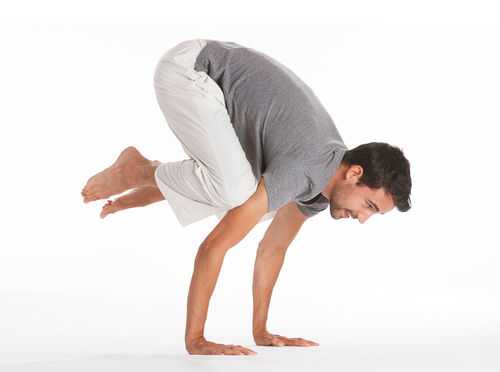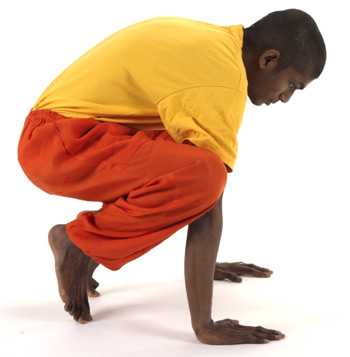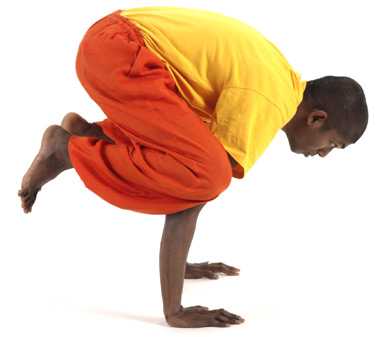

Kakasana
Crow is the name of a Hatha Yoga Asana, namely the «Kakasana». «Kakasana», the «Crow», is the 10th Asana within the 12 basic postures of the Yoga Vidya basic series and belongs to the most important 84 Asanas. Normally, the «Peacock», «Mayurasana», is actually practiced at this point. However, instead of this, the «Crow» can also be taken. This is followed by «Ardha Matsyendrasana», the «Twisted Seat».
Table of Contents
1.1 Tips for the Execution
1.2 Effects of the Crow
1.3 Physical
1.3.1 Stretched Muscles
1.3.2 Strengthened Muscles
2 Preliminary Exercises for the Crow
3 Video: Crow - Kakasana — Practical Instruction (Excerpt from a Yoga Beginners Lesson)
4 Advanced Variations of Kakasana
4.1 Out from Utkatasana
4.2 Video with Advanced Variations of the Crow
5 Intermediate Lesson at Yoga-Vidya
Execution of the Crow
The «Crow» is simpler than it looks. Here are the two main steps into the «Crow»:
1: Squat down and bring your arms between your knees. Your hands are flat on the ground in front of you – shoulder width apart. Spread the fingers so that they point a little inward. Then bend your elbows out to the sides so that the backs of your upper arms form the supports for your knees.
2: Direct your gaze forward to a specific point on the ground. Inhale, while holding the breath, lean forward toward that point, shifting your weight to your hands and raising your toes. Exhale; hold the position for three to four deep breaths. Be careful not to overextend your neck. This will block the flow of energy. It is better to keep the head in extension of the thoracic spine.
Tips for the Execution
- Let the hands, especially your fingers, do the balancing work for balance. The rest of the body remains still in its position. Repeat «Kakasana» especially in the beginning. It is normal if minor difficulties arise. This is quite an unusual position for humans. If you are afraid of falling on your face and nose, so you can put there a pillow under. Usually, however, beginners fall on their sides.
- Take care of your wrists. If you feel pain in your wrists after practicing, gently circle your hands. Do not shake your hands, as this would be counterproductive. Activate the joint fluid through the circular movements. At the same time, you can also work on the range of motion of the wrists. The joints and the hands need time to adjust to this perhaps unfamiliar load. Practice forms the master!
Effects of the Crow
This Asana imitates the posture of a cawing crow — the body weight is supported only by the elbows and hands, and the head is raised.
As one of the most useful balance poses, the «Crow» or «Kakasana» is actually easy to do, even though it looks more advanced. The secret is to bend forward far enough, not be distracted by anything, and focus all your attention on balance alone. Practicing the «Crow» will strengthen the wrists, arms and shoulders, increase concentration and increase breathing capacity by stretching the chest.
Physical Effects of the Crow
The «Crow» strengthens the arm muscles, balance and coordination and promotes body awareness. It helps to keep the nerves healthy and thus prevents all nerve problems. The wrists are strengthened and become flexible.
Stretched Muscles
- Gluteus (gluteal muscles)
Strengthened Muscles
- Trizeps (arm extensors)
- Forearm Muscles
- Adductors of the legs
- Pectoralis (chest muscles)
- Rectus Abdomini (abdominal muscles)
- Delta Muscles (shoulder muscles)
Energetic Effects of the Crow
The «Crow» has an activating and harmonizing effect. The «Ajna Chakra» and the «Sahasrara Chakra» are addressed the most.
Mental Effects of the Crow
The «Crow» develops self-confidence, courage, concentration, willpower and balance.
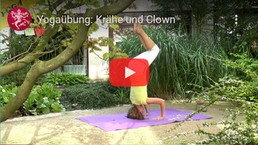
Preliminary Exercises for the Crow
Flying Dog
A wonderful preliminary exercise for the «Crow» is «Adhomukhashvanasana», better known as the «Downwards Looking Dog». This Asana is good for strengthening and stretching the back, leg, arm and shoulder muscles. The wrists are strengthened and gain flexibility. All good conditions for the «Crow» and its variations. Out from the «Dog», further work can be done on strengthening the muscles by exhaling to lower the head to the ground and inhaling to bring it up again. This exercise is called the «Flying Dog».
Another preparatory exercise is the «Elbow-Stand». Out from the «Dog» lower your forearms to the ground and you are already in this Asana. From here you can continue to practice the «Dolphin». Make slow movements with your head and torso: Exhale, place your head in front of your hands. Inhale and lift the head again.
Video: Crow - Kakasana — Practical Instruction (Excerpt from a Yoga Beginners Lesson)
The Yoga Exercise «Crow» from a Yoga Lesson: Sukadev instructs you to the «Crow» and shows you how to best set up and practice this exercise. This is an excerpt from the 8th Course Video of the 10-week Beginners Course.
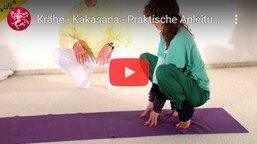
 |
 |
Advanced Variations of Kakasana
Out from Utkatasana
This is a variation of the «Crow», which is only suitable for advanced Hatha Yogis and Hatha Yoginis. You should be able to master the Basic Position of the «Crow» perfectly.
You stand in «Tadasana» and pass into «Utkatasana». Place your right ankle on your left knee and bend you complete forward so that your hands touch the ground completely. You can now rest your right shin comfortably on the back of your upper arm and lift your buttocks. Only when the buttocks have reached a high level, then you lift the left leg upward and extend the leg fully. Here it is important to observe the laws of physics: small mass follows large mass. In this case, the left leg (small mass) follows the buttocks (large mass).
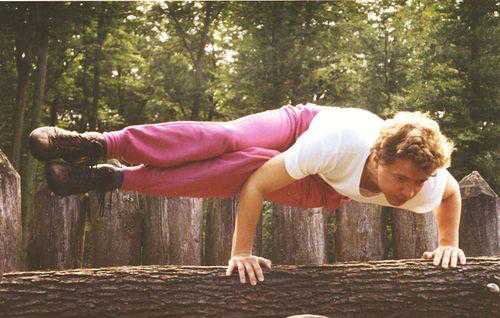 «Lateral Crow — Narendra-Kakasana»
«Lateral Crow — Narendra-Kakasana»
Now practice the other side as well. Avoid practicing crooked. Rejoice in your chocolate side and rejoice in your other chocolate side.
You can find all other variations on «Crow» under «Crow Variations» and on the Yoga Vidya pages under the following LINK.
Video with Advanced Variations of the Crow
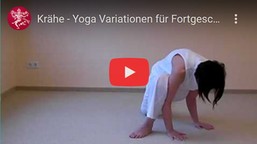
 |
 |
Intermediate Lesson at Yoga-Vidya
This video has nothing to do with the «Crow». Here you can see if you are fit for the «Intermediate Level». Here Sukadev instructs you through 20 intense minutes of Yoga, including Relaxation and Breathing Exercises at the end.
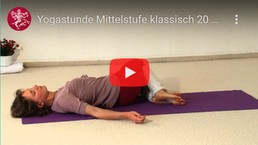
 |
 |

